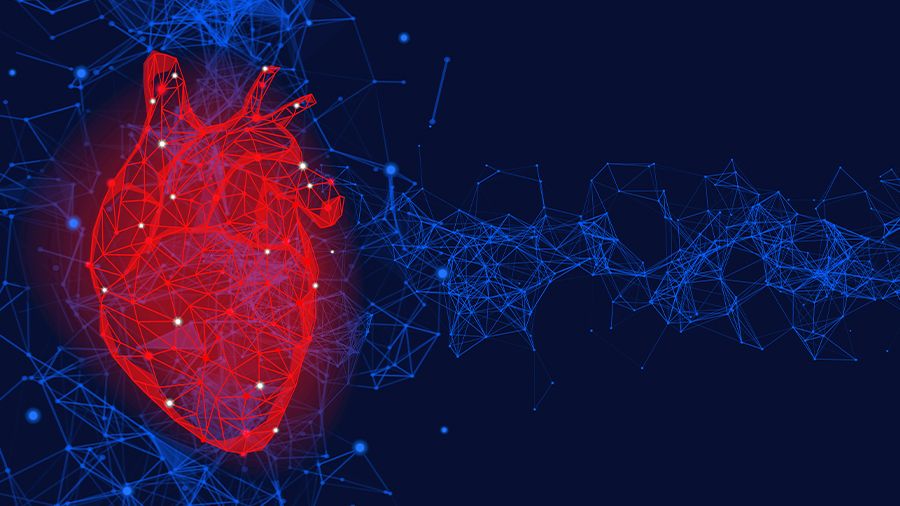Takotsubo syndrome or "broken heart" syndrome is often misdiagnosed. This is not only due to the confusion with heart attacks. How artificial intelligence helps with diagnosis and how patients are supported at the University Hospital Zurich.
Takotsubo syndrome (TTS) causes almost the same symptoms as a heart attack, with chest pain, shortness of breath and practically identical ECG and laboratory changes. However, in contrast to a heart attack, TTS does not involve an occlusion of a blood vessel, but is thought to be a spasm of the microcirculation, which acutely disrupts the heart’s pumping function. After this acute phase, most sufferers recover. Nevertheless, around ten percent of patients suffer cardiogenic shock during the acute phase. This leads to death in around half of those affected.
“Today, we assume that around four percent of all diagnosed heart attacks are actually Takotsubo syndrome,” says Prof. Dr. Christian Templin, Head of Interventional Cardiology at the Department of Cardiology at the USZ. Between 30 and 40 cases of TTS are diagnosed here every year. “Although the diagnosis is becoming increasingly common worldwide, we have to assume that the number of unreported cases is very high, as there are also larger cardiac centers where no cases of Takotsubo syndrome are diagnosed.” There is a need for greater awareness among cardiologists and the medical profession, says Templin.
The cardiologist is one of the leading international researchers into this disease and heads the world’s largest Takotsubo registry, to which 60 cardiovascular centers from 18 countries are affiliated. The latest findings on the causes, diagnosis and treatment have been made possible in part thanks to this register.
Various causes not only due to a broken heart
It is known that extreme emotional situations such as the death of a loved one, a separation, stress or bullying at work, but also extremely joyful events are triggers for TTS. This is why it is also referred to as “broken heart syndrome”. “However, we now know that extreme physical situations trigger Takotsubo syndrome more frequently than emotional triggers,” says Templin. Such triggers include asthma attacks, strokes, epileptic seizures or the administration of stress hormone medication in connection with anesthesia during operations. “We have also found that TTS sufferers often have accompanying psychological illnesses such as depression or anxiety,” says Templin.
Back in 2015, he led an international study in which neurologists and neuroscientists were able to show that functional changes exist in the brains of people affected by Takotsubo syndrome, meaning that a brain-heart association must be assumed.
Differential diagnosis not only in connection with myocardial infarction
The diagnosis of TTS is still difficult. Not only because the symptoms suggest a heart attack, but also because spontaneous coronary artery dissection (SCAD) causes practically identical symptoms to TTS, which can also lead to misdiagnosis.
“We understand many diseases very well, but with TTS and SCAD it is essential to further characterize them clinically,” emphasizes Templin. “That is why we have now created an international SCAD registry with the cooperation partners of the Takotsubo Registry.” Both diseases have very similar causes.
Artificial intelligence as an opportunity for better diagnosis
Recently, the University Hospital Zurich and ETH Zurich were able to use artificial intelligence to achieve better diagnostic results. Around 450 echocardiograms were submitted to four echocardiographers. You should evaluate whether it is a heart attack or the TTS. The same has been done with artificial intelligence at ETH. The hit rate for the AI was 79 percent, for the echocardiographers it was between 68 and 74 percent. The results are promising. Further studies are now needed, says Templin.
Treatment options and need for research
To date, there are hardly any treatment options with medication for TTS. This makes close support and comprehensive information for those affected all the more important. “We make the diagnosis in the acute phase in the cardiac catheterization laboratory and later carry out regular ultrasound checks, ECG and laboratory analyses until complete recovery has occurred,” explains Templin. Patients from all over the world come to the established international reference center for these targeted examinations. With the patients’ consent, they are included in the international Takotsubo registry.
In the most common type by far, apical TTS, the apex of the left ventricle stops and only the base pumps blood, which can lead to cardiogenic shock. In this case, the Impella pump, which is inserted via the groin, has proven to be a successful treatment. “We perform this procedure in around 40 cases a year, including heart attacks,” says Templin. Patients are closely monitored after the procedure.
